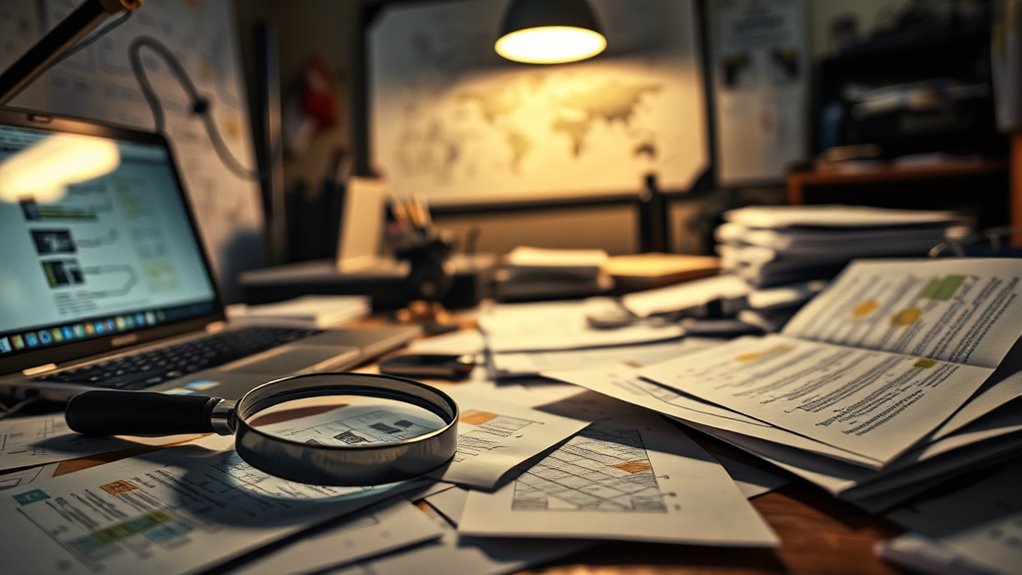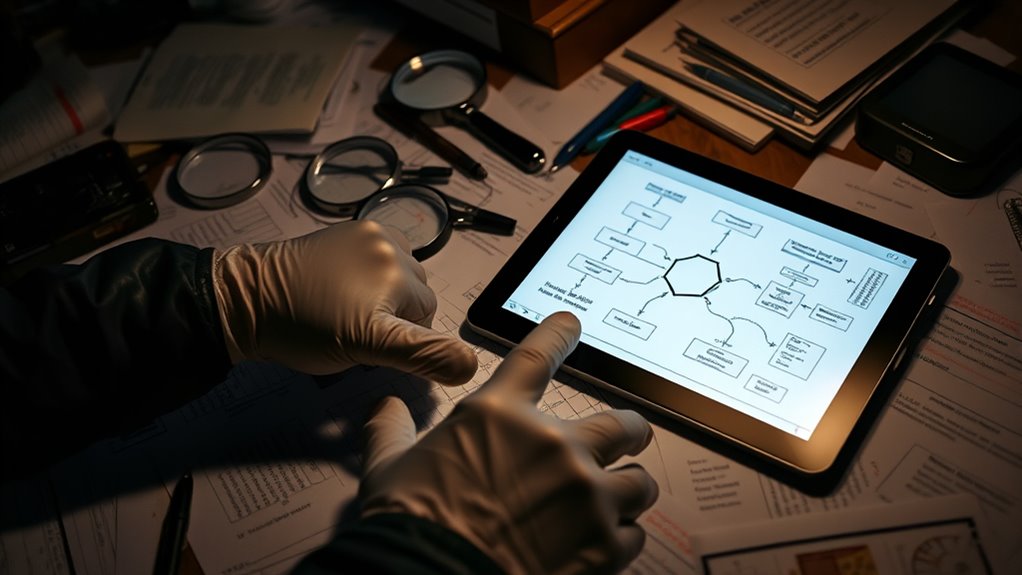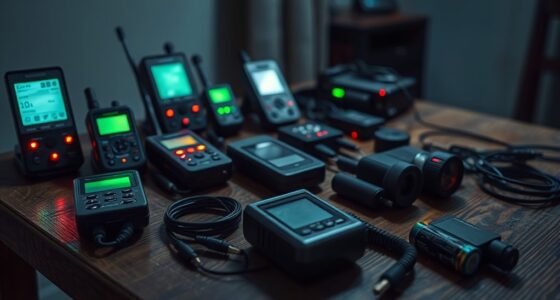To catch yourself before mistakes turn into false alarms, stay alert for early warning signs like assumptions without evidence and confirmation bias. Verify evidence through multiple sources and challenge automatic conclusions with alternative explanations. Use collaborative checks and peer reviews to maintain objectivity. By recognizing common pitfalls and employing validation techniques, you reduce errors. Keep practicing these strategies, and you’ll uncover more effective ways to identify and correct mistakes in investigations.
Key Takeaways
- Recognize early warning signs like confirmation bias and misleading assumptions to prevent errors in investigations.
- Validate evidence through cross-checking sources and digital signal verification to ensure accuracy.
- Challenge automatic assumptions and consider alternative explanations to reduce cognitive biases.
- Implement peer reviews, team collaboration, and documentation to establish checks and balances.
- Stay vigilant by regularly evaluating reasoning and being aware of common pitfalls that lead to false alarms.
Recognizing Early Warning Signs of Errors

Recognizing early warning signs of errors is essential for preventing costly mistakes in investigations. One common sign is the presence of misleading assumptions that shape your conclusions without sufficient evidence. These assumptions often stem from confirmation bias, where you favor information that supports your initial beliefs and overlook data that contradicts them. When you notice yourself selectively gathering or interpreting evidence, it’s a red flag. Be alert to signs that your reasoning is skewed, such as ignoring alternative explanations or dismissing contradictory facts. By remaining vigilant for these early indicators, you can challenge your biases and ensure your investigation remains objective and accurate. Spotting these signs early helps you correct course before false alarms or errors lead your investigation astray. Additionally, recognizing the importance of data-driven strategies can enhance the accuracy and credibility of your findings. Incorporating critical thinking skills can further aid in identifying potential errors before they become problematic. Developing a habit of questioning assumptions and verifying evidence with factual accuracy is also crucial for maintaining the integrity of your investigation. Practicing systematic analysis can help uncover overlooked inconsistencies and prevent biases from clouding judgment. Utilizing somatic awareness techniques may also help investigators stay present and attuned to their intuitive responses, which can reveal underlying biases or emotional reactions that influence judgment.
Common Pitfalls That Lead to False Alarms

One of the most common pitfalls that lead to false alarms in investigations is jumping to conclusions based on incomplete or misleading information. Misleading testimonies can sway your judgment, especially if you accept them at face value without proper verification. Additionally, overlooked inconsistencies in evidence or witness statements often cause you to miss vital details. These gaps can create a false sense of certainty, prompting you to pursue false leads. Rushing to conclusions without thoroughly examining all information increases the risk of false alarms. To avoid this, stay cautious, question every piece of evidence, and cross-check testimonies. Recognizing these pitfalls helps you prevent false alarms and keeps your investigation on a solid, fact-based footing. Incorporating sound science understanding can also help interpret evidence more accurately and avoid premature judgments. Being aware of confirmation bias is essential, as it can cause investigators to favor information that supports their initial assumptions while ignoring contradictory data. Paying close attention to evidence quality ensures that conclusions are based on reliable and verified information, reducing the likelihood of errors. Additionally, understanding the importance of technological reliability can prevent reliance on flawed or malfunctioning equipment that might produce false signals. Moreover, understanding breakdowns in communication can help prevent misinterpretations that lead to false alarms.
Techniques for Validating Evidence and Leads

Validating evidence and leads is essential to guarantee the accuracy of your investigation. You need to confirm that your findings are reliable before drawing conclusions. Techniques like forensic triangulation help verify the consistency of evidence from multiple sources, reducing the risk of false leads. Signal verification ensures that the data you interpret is genuine and not a false alarm. Use the table below to compare methods:
| Technique | Purpose | Key Benefit |
|---|---|---|
| Forensic triangulation | Cross-check evidence sources | Confirms validity |
| Signal verification | Confirm authenticity of signals | Eliminates false alarms |
| Data cross-referencing | Correlate multiple data points | Ensures accuracy |
| Source validation | Verify credibility of sources | Reduces bias |
Additionally, understanding bike maintenance can help you assess the reliability of physical evidence related to mechanical issues or tampering. Properly checking sensor data can also aid in confirming the authenticity of digital evidence, preventing misinterpretations.
Strategies to Prevent Cognitive Biases From Skewing Results

Cognitive biases can subtly influence your judgment, leading you to interpret evidence in ways that confirm preconceptions rather than objective facts. To prevent this, be aware of heuristic biases that simplify decision-making but may distort your view. Challenge automatic assumptions by actively questioning whether your initial impressions are supported by solid evidence. Watch out for confirmation fallacies—your tendency to seek out evidence that supports your beliefs while ignoring contradictory data. To counter these, adopt a deliberate mindset: seek diverse perspectives, consider alternative hypotheses, and test your conclusions against new information. Regularly pause to evaluate whether your reasoning is clouded by biases. These strategies help you maintain objectivity and ensure your investigation remains as impartial and accurate as possible.
Implementing Checks and Balances in the Investigation Process

To guarantee your investigation remains objective, establishing checks and balances throughout the process is vital. You can do this by fostering team collaboration, encouraging diverse perspectives, and regularly reviewing findings. Implementing documentation standards ensures consistency and accountability, making it easier to trace decisions and identify errors. Use a collaborative approach to cross-check data and challenge assumptions, preventing individual biases from dominating. Incorporate peer reviews and independent audits into your workflow to catch overlooked mistakes. Additionally, staying informed about industry trends can help adapt your procedures to emerging challenges and best practices. Being aware of legal guidelines relevant to investigations ensures compliance and reduces the risk of procedural errors. Regular training on investigation protocols can further reinforce adherence to established standards and minimize errors. Incorporating AI detection methods can also assist in identifying inconsistencies or false information that may otherwise go unnoticed.
Frequently Asked Questions
How Can Investigators Effectively Communicate Uncertainties to Stakeholders?
You need to prioritize clear risk communication and transparency strategies when sharing uncertainties with stakeholders. Explain your findings honestly, acknowledge any limitations, and use plain language to avoid misunderstandings. By openly discussing potential risks and uncertainties, you build trust and demonstrate your commitment to accuracy. This approach guarantees stakeholders stay informed, understand the evolving nature of investigations, and are more likely to support informed decision-making based on the best available information.
What Role Does Technology Play in Reducing Investigative Errors?
Did you know that 85% of investigative errors can be reduced with technology? AI integration and data analytics play a vital role in minimizing mistakes by identifying patterns and flagging anomalies early. You can leverage these tools to enhance accuracy, speed up processes, and catch false alarms before they escalate. Embracing technology empowers you to make more informed decisions, ultimately improving the reliability of your investigations.
How Do Organizational Culture and Policies Influence Investigation Accuracy?
You should recognize that organizational culture and policies greatly influence investigation accuracy. A culture that discourages bias and promotes transparency helps reduce errors, while policies that emphasize thoroughness and accountability guide your actions. Organizational bias can skew your judgment, leading to false alarms or missed clues. As a result, fostering a positive culture and clear policies ensures you stay objective, improve investigation quality, and minimize mistakes.
What Are the Ethical Considerations When Correcting Investigation Mistakes?
Ironically, the biggest ethical dilemma isn’t just making mistakes but how you handle them. When correcting investigation errors, you must consider confidential disclosures and transparency. Upholding integrity means addressing errors honestly, even if it exposes flaws. You face the dilemma of balancing accountability with confidentiality, ensuring you don’t compromise trust. Doing the right thing requires courage, clear communication, and a commitment to ethical standards, no matter how uncomfortable the correction may be.
How Can Ongoing Training Improve Mistake Detection During Investigations?
Ongoing training boosts your ability to detect mistakes during investigations by emphasizing continuous feedback and simulation exercises. These tools help you recognize errors early and refine your skills in real-time. By regularly engaging in simulations, you gain practical experience, while continuous feedback guides your improvement. This combination guarantees you’re better equipped to spot false alarms and prevent costly mistakes, ultimately making your investigations more accurate and dependable.
Conclusion
By staying vigilant for early warning signs, avoiding common pitfalls, and validating evidence, you can catch mistakes before they escalate. Implementing checks and balances keeps your investigation on track, reducing false alarms. Did you know that up to 60% of wrongful convictions are linked to investigative errors? Staying aware and proactive helps you uncover the truth more accurately, ensuring your investigations are thorough and reliable. Keep learning and refining your approach to stay one step ahead.









